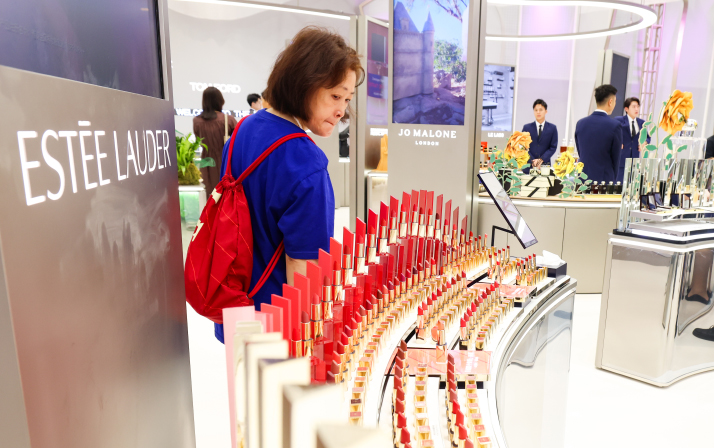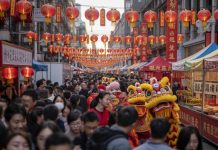
On May 20, Rihanna, the globally renowned singer and businesswoman from Barbados whose heart today lies more in beauty than music, appeared at the Fenty Beauty Alley pop-up in Shanghai. Fenty is the brand empire that Rihanna has built, including her ventures in the fashion and beauty industries.
At the Shanghai pop-up, she personally whipped up pancakes for the influencers, content creators and fans present.
Just one day earlier, the R&B hitmaker and entrepreneur had appeared in multiple beauty-related livestreams on Douyin, TikTok’s Chinese sister app, marking her debut livestreaming activity on the platform.
This trip to China aimed to boost her beauty brand, Fenty Beauty, which was jointly launched with French multinational luxury goods conglomerate LVMH Group in 2017.
Compared to promotional methods like celebrity endorsements, Fenty Beauty chose a marketing strategy that better aligns with Chinese social media: interacting with multiple high-profile celebrities, vloggers and online personalities, and engaging in live-commerce, a combination of livestreaming and e-commerce, on Douyin, one of the most popular mobile apps in China today.
Fenty Beauty’s culturally adaptive marketing is more than just a strategic shift. It, to a certain extent, reflects the difficulties and struggles faced by foreign beauty brands in China.
For the past few decades, imported cosmetics have been synonymous with high-end and high quality in the eyes of Chinese consumers, driving the Chinese market to become a major growth engine for them.
Recently, however, the previous winners found themselves having to deal with unprecedented challenges: declining sales, slowing growth and the rise of domestic brands competing for market share. More importantly, due to the rapidly changing Chinese market and shifting consumer trends, foreign beauty companies seem to face increasing difficulties in understanding the Chinese market.

Facing defeat
Linda Xie, a teacher at a university in south China, feels that expensive beauty hauls are becoming a thing of the past. She now focuses solely on skincare essentials, joining millions of other Chinese consumers who have reduced their spending on cosmetics.
“In recent years, I’ve bought so many products,” the 29-year-old from Guangzhou, capital of Guangdong Province, told Beijing Review. “My bathroom cupboard is full; it’s hard to justify needing much more.”
Data from the National Bureau of Statistics show that, from January to July, total retail sales of cosmetics in China reached 241 billion yuan ($34 billion), a slight year-on-year increase of 0.3 percent. However, figures from the General Administration of Customs of China reveal that the nationwide import value of beauty cosmetics and toiletries dropped 11.1 percent, amounting to $9.7 billion, during the same period.
Take Shiseido as an example. In the first half of the year, the Japanese beauty group saw a modest 0.8-percent sales growth in the Chinese market, but its core operating profit declined by 10.1 percent.
The anxiety of foreign beauty giants stems not only from their own sluggish growth but also from the intense competition from local brands. In the past year, Chinese local skincare brands have achieved overall growth on e-commerce platforms. During the 2023 Double 11 online shopping festival (October 31-November 11), Chinese cosmetics and skincare brand Proya surpassed L’Oréal in rankings, becoming the top brand on Tmall, a major Alibaba Group e-commerce platform, and Douyin. Skincare label Hanshu, known for its natural ingredients, also retained the top spot in the Douyin beauty category for seven consecutive months from January.
Recently, some Chinese beauty brands have established partnerships with leading fashion publication Vogue China. Given Vogue’s global stature, featuring homegrown brands like Florasis and Proya on the magazine’s official social media accounts boosts their exposure and brand positioning.
Tang Xiaotang, a fashion industry analyst, told Chinese newspaper National Business Daily, “The lackluster performance of international beauty companies in China is partly due to the market environment, where overall high-end consumption is facing challenges. On the other hand, the penetration rate of skincare products in China is very high, already somewhat saturated, leading to fewer stockpiling behaviors during promotional periods.”
The weight of “why it’s worth buying” has increased tremendously, even surpassing the sense of value brought by the brand name itself.
Wu Zhigang, founder of brand consulting agency OIB.CHINA, a brand service company in Shanghai, told National Business Daily, “Many international brands have treated China as a harvesting ground in the past few years, without effectively building their products and marketing. Chinese consumers have become very mature and seek newer things, but these brands have not innovated effectively. Therefore, they are facing a backlash today.”
“Both domestic products and their affordable alternatives are quite good, with safe ingredients. And in terms of efficacy, I don’t see much difference for me,” Xie told Beijing Review.
The struggle
The rise of e-commerce in the beauty sector has, to some extent, leveled the playing field between high-end and mass-market products, diluting the competitive edge that luxury brands once had. In terms of content marketing and livestreaming sales, international brands are starting on almost equal footing with domestic cosmetics companies.
Domestic brands have consistently gained traction on social platforms like Douyin and Xiaohongshu by utilizing influencer marketing, short videos, mini-dramas and variety shows. During livestreaming sessions, they employ a range of marketing strategies: Company executives join in, founders co-host with influencers, and executives appear on variety shows where they negotiate prices with hosts, effectively merging live-commerce with brand marketing.
“In recent years, the best growth for international brands has been in high-end department stores in small cities,” Wu said, adding that it is essential to enable consumers to actually touch and try the products in their immediate surroundings.
For century-old overseas brands with a high-end positioning, however, the question of whether they should maintain their premium status and increase prices, or adapt to local consumer preferences, is complex. The answer is not straightforward.
Some beauty giants are taking steps to safeguard their market positions. Some are investing in new categories—like L’Oréal, which has invested in local Chinese perfume brands such as Guanxia. Others are pinning their hopes on product innovations, such as Estée Lauder upgrading its classic Little Brown Bottle serum to a larger “brown jar” format with improved ingredients. Some companies are expanding further into lower-tier markets, as seen with French skincare and beauty label L’Occitane, which continues to open stores in small cities and towns while increasing its marketing investments.
The strength
Although the growth of foreign brands in China has slowed, these giants still have a solid foundation and maintain a flexible and diverse brand matrix.
For instance, L’Oréal halted sales of its professional makeup line NYX but relaunched fragrance label Atelier Cologne and quickly expanded the brick-and-mortar presence of its newly acquired Australian skincare label Aēsop in China. After its beauty brand Benefit Cosmetics exited the China market, LVMH quickly introduced Fenty Beauty to fill the gap. Additionally, Japanese premium skincare hard brand SK-II partnered with Harper’s Bazaar China magazine, which boasts 2.3 million followers on Douyin, to showcase its newly launched facial treatment essence across four dedicated posts.
These facts demonstrate that high-end beauty products still have strong appeal in China. However, they must present more scientifically backed narratives to persuade consumers to actually buy them.
“For regular consumers, when we consume, we also want to know very clearly why we are paying higher prices for certain brands,” Xie said. –The Daily Mail-Beijing Review news exchange item





